The impact of individual accounts on women is likely to surface as an important issue as we consider Social Security reform in the United States. The experience of Latin American countries that have already adopted these reforms sheds light on how women will be affected and which design features are likely to produce desirable outcomes. This paper analyzes the differential impact on the two genders of pension reforms in Chile, Argentina and Mexico, which have adopted systems in which social security benefits are primarily financed by mandatory savings in individual accounts. We found that, in general, benefits of women improved relative to those of men, and low-income women were the biggest gainers from the reforms.
Social security can have different impacts on men and women because of economic and demographic differences between the two genders.
Less formal labor market work, lower wages for women. Although the labor force participation rate of women has been rising, it is still only 75 to 80 percent that of men in the United States, and the disparity is even greater in Latin America. In industrialized countries, the average hourly wage rate of women is 15 to 30 percent below that of men, and it is even lower in Latin America. These factors lead to smaller pensions for women in traditional defined benefit systems such as that in the United States and to smaller retirement saving accumulations in defined contribution systems, such as those in Chile, Mexico and Argentina.
Greater longevity and widowhood. Since women live two to four years longer than men in most countries and are typically younger than their husbands, women are more likely to become widows than men are to become widowers. In the United States, 34 percent of women aged 65 to 69 are widows, compared with 7 percent of men, and by age 85-plus only 9 percent of women (but 48 percent of men) are still living with their spouses. Due to household economies of scale, it costs one person about two-thirds as much to live as two. Yet household income is likely to fall to one-third of its previous level when the husband dies. This underscores the importance of survivors' benefits to women.
Poverty among very old women. With low benefits and without survivors' benefits, very old women become relatively poor in many countries.
To project how the two genders are likely to fare under the new systems in Chile, Argentina and Mexico, we used household surveys to construct the wage and employment histories of representative men and women in these countries. We then simulated what their pensions would be under the new and old system rules. Because the old systems were insolvent and unsustainable, their future benefits were uncertain. Therefore, instead of comparing the absolute dollar value of benefits, we compare the relative position of men and women with similar education under the new and old systems and the new-system benefits of women with differing educational levels and labor market experience. The major findings are:
- Women have generally gained under the new systems, relative to men.
- Women in the lowest educational categories are the biggest gainers.
- In Chile and Mexico, women who have worked a full career gain the most; but, in Argentina, women who spent much of their time working in the home receive the largest rates of return on their contributions.
The total pensions of women in these countries come from three sources: their personal accounts, public benefits that are targeted toward low earners, and the joint pensions that husbands are required to provide. These three together comprise the new social security system. How much does each source provide?
Personal accounts. Generally, compared with men of similar educational backgrounds, personal accounts are projected to provide monthly benefits 30 to 40 percent of men's for "average" women who work in the formal labor market for about half their adult lives and retire five years earlier than men. In contrast, women who work full careers and retire at the same age as men receive pensions from personal accounts that are 60 to 70 percent those of comparably educated men, because of lower wages and contributions.
Public benefits. Low-wage workers, many of whom are women, gain from public benefits designed to ensure a minimum retirement income in the new systems. These public benefits are more targeted toward low earners than were the old systems in Latin America or the current system in the United States. In Mexico a uniform public contribution is added to the accounts of all workers for each day they work; in Chile workers are given a public benefit if the pension from their invested accounts falls below a guaranteed minimum; and, in Argentina, workers receive a flat benefit in addition to the income from their accounts.
Joint pensions. In all three countries, husbands are required to purchase, with the money in their personal accounts, a joint annuity (or other pension) to provide for their surviving wives. Most important, women are allowed to keep their own pension in addition to this joint annuity. This means that working women are no longer penalized, as they are in the United States and other countries where they must give up their own benefit (to which they have contributed many years) in order to receive the widow's benefit. The combination of the two benefits, both of which are financed by personal accounts, allows widows to maintain their previous standard of living without imposing a burden on taxpayers. Joint pensions raise the lifetime benefits of married women with full work careers to levels equal to or higher than the benefits of men. For example, comparing women and men with an incomplete high school education:
- In Chile, the lifetime benefits of married women with full work careers rose from 71 to 97 percent of men's benefits.
- In Argentina, their benefits rose from 65 percent to 108 percent of men's.
- In Mexico, women's benefits rose from 80 percent to 98 percent of men's.
The most important features of the new systems for women are: personal accounts whose benefits they own throughout their lives, joint pensions from their husbands that they are entitled to receive in addition to their own pensions, and public benefits that are targeted toward low earners, who are disproportionately female. The requirement of annuitization or other gradual withdrawal of money in the accounts and indexation of benefits are also particularly important to women because of their greater longevity. The public benefit is price-indexed in Mexico and has been rising faster than prices and on par with wages in Chile, where private annuities are also price-indexed. We can draw on the experience of these three countries to design an individual account system in the United States that improves women's relative positions and increases work incentives while also solving the problem of Social Security's long-term financial shortfall.
[page]"In pay-as-you-go social security systems, retirement benefits of current retirees are funded by taxes on current workers."
1Most public pension systems are financed on a pay-as-you-go basis, which means that the retirement benefits of current retirees are funded by taxes on current workers. Due to increasing life expectancies, falling fertility rates and generous benefits, these systems face growing financial shortfalls and require high tax rates that deter economic growth. To address these problems, a number of countries have adopted pension reforms in which social security benefits are primarily funded by individual investment accounts with payroll contributions from workers. Personal accounts are supplemented by a public benefit, more or less targeted toward low-income workers. Some countries also have adopted or are contemplating requirements for joint annuitization or sharing of pension rights and/or personal account balances between spouses.
These reforms have reduced the future unfunded liabilities of public pension systems, financed part of the benefit through investment earnings rather than taxes, and changed the distribution of benefits and costs. They have had different effects on men and women, single workers, and married workers and their spouses. This paper considers the gender impact of reforms adopted over the past 20 years in three Latin American countries: Chile, Argentina and Mexico. The old systems in these countries were traditional defined benefit pay-as-you-go schemes similar to that in the United States. The new systems strongly rely on individual accounts.
"Chile, Argentina, Mexico and other countries have adopted reforms that rely on personal accounts funded by workers and invested in stocks and bonds."
We can use their experiences to draw inferences about which design features are likely to produce desirable gender outcomes in the United States. The gender impact of social security reform is important because the majority of the old and the vast majority of the very old are women. In the United States, 60 percent of people over the age of 65 and 72 percent of those over age 85 are women, and this disparity has been increasing through time. Furthermore, women are more dependent on social security for retirement income than are men, and women are a disproportionate share of retirees living in poverty. Very old women constitute a persistent pocket of poverty in our society.2
In order to analyze the effects of the reforms, we use household survey data to construct the wage and employment histories of representative men and women in Chile, Argentina and Mexico. We use the histories to project what their pensions will be under the new systems and what they would have been under the old systems.3 We examine how the shift to the new systems affected women versus men and the differential effects on various subgroups of women – those with high versus low educational backgrounds, those who have continuous attachment to the labor market versus those who work primarily in the home, and single versus married women. We emphasize the key design features that determine these gender outcomes. We find that Latin American reforms have raised the level of benefits of women relative to those of men and of low-income workers – many of whom are women – relative to high earners. [For a discussion of Methodology, see Appendix I.] [page]
"In general, woman work fewer years than men and earn fewer wages, yielding lower retirment incomes."
In most public pension programs, workers receive benefits that depend on wage history, years of work or more directly on their contributions. These contributory social security systems developed because pensions were viewed as a replacement for wages upon retirement and people are more willing to pay the tax that finances the system if they receive a contingent monetary benefit in return. However, women are likely to have worked and contributed for fewer years than men and to have earned lower wages when working, which gives them a smaller pension when retired. The labor market and demographic differences between men and women that affect their pensions are well known.
Labor Market Differences between Women and Men. Differences in employment and wages and the lower retirement age for women than men in many social security systems reduce benefit levels.
Labor force participation rates. Women, especially married women, traditionally have less continuous employment than do men due to the division of labor within the family.
- By the age of 65, the average woman without a university degree in all three countries has accumulated 18 to 27 years of work experience, while the average man has accumulated 38 to 44 years.
- On average, women in Chile work and contribute to the system only 70 percent as many years as men, while in Argentina and Mexico this ratio is only 50 to 60 percent.
- In all three countries, the gender gap in labor force participation narrows substantially for the minority with higher education but it never completely disappears.
A large gender gap persists in industrial countries too. For example:
- In the United Kingdom, Canada and Australia the female labor force participation rate is 15 percent to 25 percent below that of men, and much of the female labor is part-time.4
- In 1960 the female labor force participation rate in the United States was less than 50 percent that of men, but by 1996 it had climbed to 80 percent that of men.5
In the United States, women's labor market experience is converging with that of men, and younger cohorts are more likely to remain in the labor force throughout most of their adult lives. However, this convergence is very gradual and the growth in the propensity of women to work seems to be slowing.
Wages. In Chile, Argentina and Mexico, younger women who work earn almost as much as men, after controlling for age and education. However, earnings diverge with age – prime age male earnings rise 2 to 3 percent per year while female earnings rise 1 to 2 percent per year.
- In these countries, at age 20 women earn on average almost as much as men, but the wage disparity increases with age and by age 50 they earn only 60 percent to 70 percent as much per month of work.6
- In the United Kingdom, Canada and Australia, women's hourly wage rates, on average, are 70 percent to 85 percent as much as men's.7
- In the United States, median earnings for full-time women are 70 percent those of men but this becomes 80 to 85 percent after controlling for age, education, work effort and other relevant variables.8
"The normal retirement age is five years earlier for women than for men in Chile and Argentina; thus they contribute and earn interest on personal accounts for fewer year and their annuities are spread over more years of retirment."
Different retirement ages for men and women. Social security rules in many countries allow women to retire earlier than men. For example, women are permitted to retire five years earlier than men in Chile and Argentina, and also in many European countries. These differential rules started in traditional defined benefit systems and they frequently continue in reformed systems. The United States is one of a small group of countries with equal retirement ages for both genders and this helps to equalize social security benefits for men and women with the same earnings.
Demographic Differences between Men and Women. The longer life expectancies of women and the greater likelihood that they will be widowed in old age increases their chance of poverty in retirement. This is especially true in countries with an earlier retirement age for women than for men.
Longevity. In most countries, women at age 60 have a life expectancy that is three to five years greater than that of men. They also tend to marry men a few years older than themselves. In Chile, for example, a woman who retires at age 60 can expect to live 7.5 years more than her husband when he retires at age 65, on average. In the United States the difference in life expectancy at age 65 is three to four years and, in addition, wives tend to be younger than 65 when their husbands are 65. Thus any given retirement accumulation yields lower annual pensions for women, especially if gender-specific mortality tables are used for annuitization, as in Latin America. In the United States, unisex tables are implicitly used by the Social Security system and are required in employer-sponsored pension plans.
Widowhood. Because they are younger than their husbands and have greater life expectancy, women are more likely to become widows than men are to become widowers. In the United States, 72 percent of women age 80 to 84 are widowed but only 27 percent of men. In the 85-plus age group, only 9 percent of women are living with their spouses.9 Hence survivors' pensions are of key importance to women. Without survivors' benefits, nonworking widows are likely to find themselves impoverished. Even widows who have a pension of their own would find their household income cut by as much as 70 percent without survivors' benefits. Since household costs fall by only 35 percent when the husband dies, due to household economies of scale, widows find their income falls far more than their cost of living. Survivors' benefits fill in this gap.
[page]With variations described below, the system adopted in Chile was emulated in Mexico and Argentina, as well as in other Latin American and European countries making the transition from socialism to market economies.
"In Chile, workers invest 10 percent of their wages and receive a public benefit if their annuities are less than the Minimum Pension Guarantee."
Chile. In 1981, Chile replaced a mature traditional pay-as-you-go defined benefit system with an individual account buttressed by a government-financed minimum pension guarantee (MPG). Mandatory payroll contributions are paid to competing private investment managers, rather than to a public fund. Workers contribute 10 percent of payroll for investment plus about 3 percent for administrative fees and premiums for disability and survivors' insurance.10 Upon retirement (age 65 for men, 60 for women), workers can make gradual withdrawals from their accumulated savings spread over both spouses' lifetimes, or buy an annuity that must be joint for married men.
Those who have worked at least 20 years have a minimum pension guaranteed (MPG). If the worker's private retirement savings do not reach the MPG level, the government uses general revenues to top it up. The MPG is not formally indexed to prices but so far has risen faster than prices, roughly at the same pace as average wages, due to ad hoc increases by the government.11
"In Argentina, workers invest 7.75 percent of payroll, and full-career workers – mostly men – receive a reduced flat public benefit."
Argentina.12 In Argentina, workers contribute 11 percent of payroll, which includes 3.25 percent to cover administrative fees and survivors' and disability insurance fees and 7.75 percent for investment in an individual account.13 Upon retirement (age 65 for men, 60 for women), the accumulated assets are taken out in the form of gradual withdrawals, annuities (joint annuities with 70 percent to the survivor for married men) or a lump sum for account balances above the minimum annuity amount.
Instead of a minimum pension guarantee, Argentina provides a basic "flat" benefit in addition to the personal account. It was originally financed by a payroll tax, but general tax revenues have now been partially substituted. The flat benefit is paid to all eligible workers rather than being a top-up for the few, making it roughly 10 times as costly as an MPG set at the same percentage of the average wage.14 To contain costs, eligibility is restricted to workers with at least 30 years of contributions – which excludes most women. Workers, mainly women, who reach age 70 with 10 years of contributions are granted a reduced flat pension that is 70 percent of the full flat benefit.
"In Mexico, workers invest 6.5 percent of payroll in retiremnt accounts and 5 percent in a housing account they can use for retirement."
Mexico. In Mexico, a contribution of 6.5 percent of payroll is made to individual accounts. Disability and survivors insurance while working are financed separately. Workers choose from among competing investment managers. Retirement income is augmented by a 5 percent contribution of each worker's wage to a housing fund, called INFONAVIT. If a worker does not borrow the money in the housing fund to purchase a home, it becomes part of his or her retirement assets.15 Upon retirement at age 65 for both genders, workers choose between an annuity (joint annuities with 60 percent to the survivor) or gradual withdrawals spread over both spouses' lifetimes.
The state helps finance this system in three ways. First, it pays a flat "social quota" (SQ) into each worker's account for each day of work, equal to 5.5 percent of one daily minimum wage. The SQ is financed out of general revenues, and it is designed to increase the accounts of low-income workers and their incentives to join the system. The SQ is price-indexed (as is the minimum wage) but initially was 2.2 percent of the average wage. This percentage will decline as wages rise faster than prices over time. Second, workers who contribute for a total of 25 years are guaranteed a minimum pension, initially equal to the minimum wage (40 percent of the average wage) indexed to inflation. Third, although the new system is mandatory for new workers, those who were already in the labor force when the reforms were made can opt back into the old system upon retirement.
[page]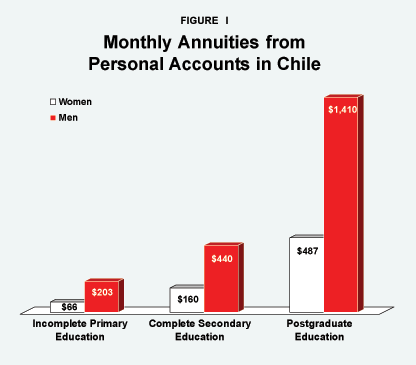
"The old social security were insolvent and Argentina was already defaulting on payments to retirees."
Comparison of the new and old social security systems in Latin America is difficult because the old systems were insolvent and unable to provide the promised benefits. In the long run, the countries we are considering faced the prospect of raising taxes (which were difficult to collect) and/or reneging on their pension promises. Chile was facing financial insolvency even in the short run and Argentina was already defaulting on payments to retirees. Because of the uncertainty regarding these benefit payments, instead of comparing the dollar value of benefits we compare the relative position of men and women under the new and old systems and the new system benefits of women with differing education levels, labor market experience and marital status.
We estimate the monthly benefits that representative women and men would receive from annuities based on their personal retirement accounts. However, our focus is on lifetime benefits because the retirement age changed as part of these reforms, it differs across countries and subgroups within each country, and the widow's benefit starts at a much later age than benefits based on own earnings. This analysis allows us to determine the extent to which reforms have improved the ratio of women's benefits to men's and which subgroups of women have gained the most, even if we can not specify absolute amounts. All monetary values have been converted to 2002 U.S. dollars. (The assumptions about future wage growth and interest rates made in our simulations of lifetime benefits are discussed in Appendix I.)
Income from Women's Own Annuities. Under the new systems, because of their lower lifetime earnings, women with average work experience receive smaller monthly annuities from their own retirement accounts than do married men with similar educations. However, the benefit gap between full career women and men is narrower. To simplify, we assume that all workers retire at the legal retirement age, which is 60 for women in Chile and Argentina, 65 for women in Mexico and 65 for men in all three countries. Results based on other retirement ages may be found in Appendix II. We show these results for three educational categories, roughly corresponding to primary, secondary and higher education. (Educational levels in these three countries are lower than in the United States and many current workers have not completed primary school, although this is less likely to be the case in the future.)
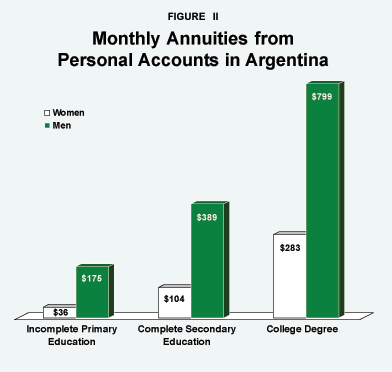
Chile. As Figure I shows, in Chile, on average:
- A woman who did not complete primary school can purchase a monthly annuity of $66 with the funds in her account; if she has completed secondary school she can get a $160 annuity; and with a university degree plus some postgraduate work she can get $487.
- In contrast, a typical male worker at these three levels of education can purchase a monthly annuity that pays $203, $440 and $1,410, respectively.
- Thus, these women receive approximately one-third as much as men with similar education.
Argentina. As Figure II shows, in Argentina, on average:
- A woman with an incomplete primary education can afford a $36 monthly annuity, one who has completed secondary school can get $104, and a woman with a university degree can get $283.
- Men with comparable education can purchase annuities of $175, $389 and $799, respectively.
- Thus, women get only 20 percent to 35 percent as much as men, because they have worked much less, and at much lower wages.
Mexico. Figure III shows a similar situation in Mexico:
- Women who have not completed primary school are projected to receive monthly annuities of $86, with some secondary education this becomes $137 and with some university education $453.
- By comparison, men at these educational levels get $289, $413 and $891, respectively.
In Mexico, women are projected to get 30 percent to 50 percent as much as men with similar education.
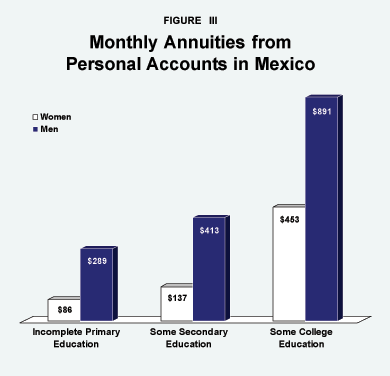
Impact of more work and contributions. In Chile and Argentina, the normal retirement age for women is five years lower than that for men. If women in these countries worked to age 65, they would collect interest for five more years and their annuities would cover five fewer years. As a result, their monthly pensions would increase by 50 percent. In reality, women are unlikely to work to age 65, but men often retire early, by age 60. Data from Chile indicates that this is quite common, causing the gender gap in monthly annuities to shrink.
"Public benefits supplement the annuities from personal accpounts, especially for low-income workers."
Some women work more than average – in fact, they may work as much as men. The monthly annuities of these "full career" women are much higher. In general, they are 60 percent to 70 percent as large as the annuities of men. The remaining difference is due mainly to the lower wages that women receive and the smaller contributions they therefore make.
Income from Public Benefit. As previously discussed, the new systems also provide a public benefit that goes disproportionately to low earners. This raises the total pension of women by a higher percentage than that of men because of their lower wages and smaller retirement accounts. These public benefits raise the female/male ratio of total retirement income and produce a higher rate of return on contributions for women than for men. But the precise effect on women depends on the design of the benefit.
Chile. The reformed system has a Minimum Pension Guarantee (MPG):
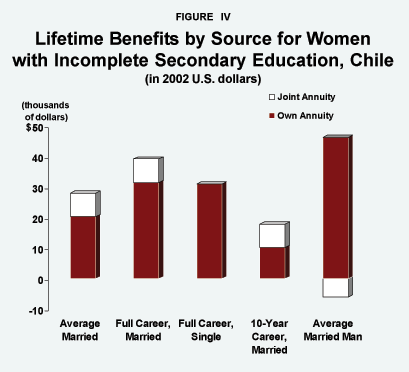
- The MPG provides the equivalent of a $12 monthly top-up to the annuity of the average woman who has not completed primary school, raising her total pension by 18 percent.
- Women in higher educational categories do not receive this benefit because their own annuity is above the MPG floor, and for the same reason very few men or women with full lifetime work and contribution histories receive this public benefit.
- Twenty years of work are required to be eligible for the MPG. Thus, low-earning women are encouraged to work 20 years, but they are discouraged from working more than 20 years because if their own annuity increases their public benefit will decrease.
"Public benefits – Chile's MPG, Argentina's flat (and reduced falt) and Mexico's SQ – also raise women's retirement income porportionately more than men's."
Argentina. In contrast to Chile, most Argentine men are eligible for the flat public benefit of $77 a month, and receive it regardless of income. Most women do not work enough years to qualify for the full flat benefit, but many receive a reduced flat benefit that begins at age 70. As shown in Appendix Table II:
- The monthly annuity of women with primary or secondary education is supplemented by a $53 reduced flat benefit, which increases their total pension by 147 percent at the primary level and 52 percent at the secondary level.
- In comparison, the full flat benefit increases monthly pension for men by 44 percent at the primary level and 20 percent at the secondary level – a much smaller percentage because of the larger own-annuities that men receive.
- Women with a college degree work long enough to get the full flat benefit of $77, which adds 27 percent to their pension, but this same benefit adds only 10 percent to the pension of men with a college degree.
- Since the flat benefit is financed, in part, by a tax on wages, the fact that men earn more than women and get a smaller benefit relative to their wages and annuities means that women are getting a higher total return on their contributions.
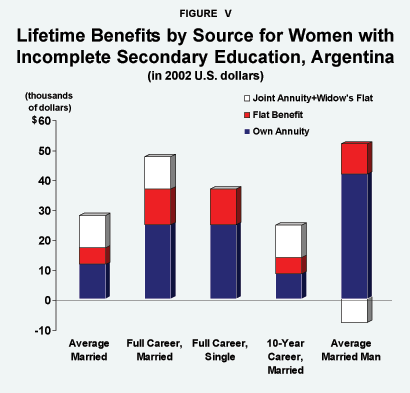
Ten years of work are necessary to become eligible for the reduced flat benefit. Since women who work only 10 years contribute little but get a relatively large public benefit, they receive the largest subsidies. This may discourage market work among women. (The Argentine government is considering eliminating the reduced flat benefit or linking it more closely to years of service, which will significantly affect women's incentive to work.)
Mexico. Finally, Mexico's Social Quota (SQ) adds a flat amount to every worker's account for each day worked. This, too, means that the percentage increment to pensions falls as incomes rise:
- The SQ adds 62 percent to the monthly pension of women with incomplete primary education, compared with a 36 percent increment for men.
- It adds 44 percent for women with partial secondary schooling, compared with 25 percent for men.
- Women with some university education get a 30 percent increment from the SQ, while men get an 11 percent increment.
- Because Mexico's SQ gives an extra benefit for every day of work, it encourages work by women more than do the public benefits in Chile or Argentina.
Mexico also offers an MPG, but 25 years of work are required for eligibility. Since most low-earning women work less than 25 years, and most men have own-annuities that exceed the MPG floor, it is projected to have little impact if it remains price-indexed.
"Husbands are required to purchase a joint annuity for their wives, which widows receive in addition to their own annuity."
Income from Joint Annuities. The gender gap in retirement income from women's own annuities and public benefits is offset further by joint annuities (or widows' benefits) that husbands are required to provide for their surviving wives. Joint annuities benefit only married women. These intrahousehold transfers are an important part of the new systems. In Chile and Mexico the widow gets 60 percent, and in Argentina 70 percent, of the husband's benefit. This adds 30 percent to 70 percent to her own annuity on a lifetime basis. It compensates for the lower wages and greater longevity of women.
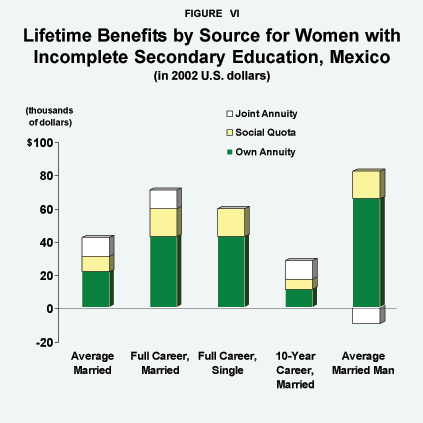
The joint annuity is especially important because a widow's cost of living is estimated to be roughly 70 percent that of a couple's cost, due to household economies of scale. The widow's benefit plus her own benefit maintains her purchasing power at 70 percent to 80 percent of the previous level, so her standard of living is unchanged when her husband dies. The joint annuity also protects women who did not work at all in the formal market.
Most important, since her husband rather than the public treasury has paid for the joint annuity, the widow is allowed to keep her own annuity in addition to the survivors' benefit. This contrasts with earlier systems in Chile and Argentina, where women had to give up their own benefits to get the widow's benefit. Since women got no additional benefit for their own contributions, their work and participation in the social security system was penalized and discouraged under the old systems. The new systems encourage work.
Total Lifetime Pension from Own-Annuity, Public Benefit and Joint Annuity. Our discussion now shifts to total lifetime benefits, rather than monthly pension incomes, because the widow's benefit, and in Argentina the reduced flat benefit, start at a much later age than do benefits based on own earnings. Expected lifetime benefits are measured in terms of their present value when each person reaches age 65. Figures IV to VI show women's projected lifetime benefits in 2002 U.S. dollars, and the amounts from own annuities, joint annuities and public benefits for women who did not complete high school – which is very common in Latin America. We distinguish by work experience and marital status. The sum of all three benefits brings the lifetime pension of full career women very close to and sometimes above that of men. Data on women with other levels of education can be found in the Appendix Tables.
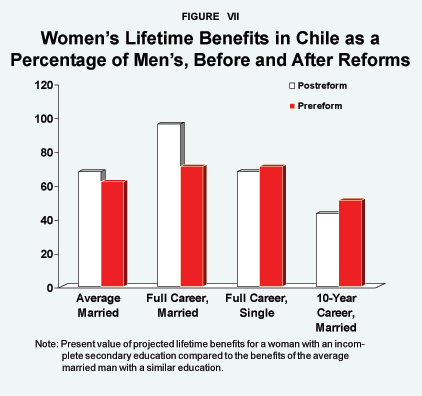
Chile. Figure IV shows the accumulated lifetime benefits from the own-annuity and joint annuity for women with an incomplete secondary education under the new system:
- A woman who works only 10 years could fund an annuity at retirement that yields lifetime benefits of $10,200, but for the average woman who works 24 years this increases to $20,300.
- By contrast, the average married man accumulates enough to fund an individual annuity that yields lifetime benefits of $46,300, but this is reduced by $6,000 that is used to finance the required joint annuity, bringing the net total to $40,300.
- The survivor's benefit from the joint annuity increases the lifetime benefits of married women by $7,700.
- Thus, a married full career woman receives $31,500 from her own annuity plus $7,700 from the joint annuity, for a total of about $39,200, which is practically the same as that of a comparable man.
Argentina. As Figure V shows, in Argentina all eligible workers receive a flat or reduced flat benefit, and surviving spouses receive a portion of the husband's flat benefit, in addition to the joint annuity. As a result:
- A woman who works only 10 years can purchase an annuity at retirement that yields lifetime benefits of $8,300, but the average woman who works 20 years can get $11,500.
- These women also get a reduced flat benefit that totals $5,500.
- By contrast, the average married man could fund an individual annuity that yields lifetime benefits of $41,700, but this average is reduced $7,900 by the joint annuity requirement and augmented $10,000 by the full flat benefit, bringing the total to $43,800.
- The survivor's benefit from the joint annuity increases the lifetime benefits of married women by $8,300, and they are also entitled to a portion of their husband's flat benefit – another $2,500.
- Full career married women, who work for most of their adult lives, accumulate an annuity from their own account of about $24,800, plus the full flat benefit that has a lifetime value to them of $11,900, plus the proceeds from the joint annuity and the widow's portion of the husband's flat benefit, which together total $10,800. Thus, their lifetime benefits are $47,500 – 108 percent of the lifetime benefits of the typical married man.
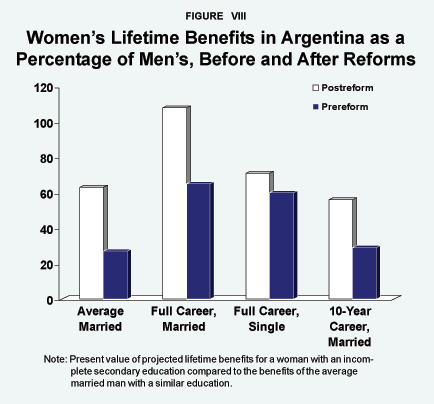
Mexico. As Figure VI shows, for men and women with a ninth-grade education:
- A woman who works only 10 years can purchase an annuity that yields lifetime benefits of $10,700, but this increases to $21,300 for an average woman who works 22 years.
- This is augmented by $9,200 from the social quota for the average woman.
- In contrast, the average man accumulates $65,100 in his own account and $16,600 from the social quota, but he must use $9,900 of this to finance the joint annuity, bringing his total to $71,800.
- Married women, on average, get a joint annuity worth $11,000.
- Thus, the full career married woman accumulates $42,500 in her own account plus $16,600 from the social quota plus $11,300 from the joint annuity, bringing her total to $70,400 – approximately the same as that of the average man.
Women's Benefits Relative to Those of Men, Before and After Reform. As previously mentioned, uncertainty regarding future benefit levels under the old insolvent systems prevent us from comparing the absolute dollar values of the benefits women would have received under the old systems to their benefits under the new system. However, we can compare the projected female/male ratios of benefits before and after reform, since these are less likely to be changed by attempts to achieve fiscal solvency. In all three countries, the new systems provide total lifetime retirement benefits for the average married woman of 60 percent to 90 percent those for men, and lifetime benefits for full career married women usually equal to or exceeding those of men. For married women, gender ratios are generally higher in the new systems than they were in the old systems. This is especially true for workers in the bottom educational categories. Below we compare gender ratios of lifetime benefits for workers with incomplete secondary education. Other comparisons are presented in Appendix II.
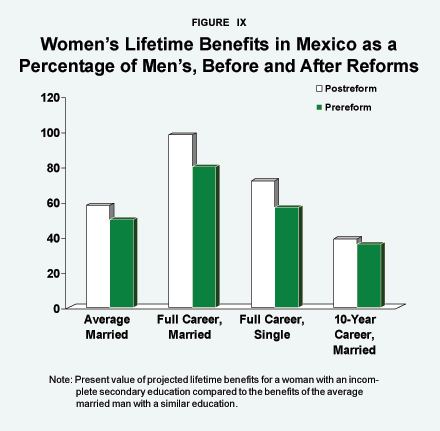
Chile. As Figure VII shows, in Chile:
- The average married woman's lifetime benefits rose from 62 percent to 68 percent that of the average married man with a similar education.
- Benefits of full career married women rose from 71 percent to 97 percent of men's benefits.
- Single women who worked a full career, however, saw a small decline in their benefits relative to men's, from 71 percent to 68 percent.
Argentina. As Figure VIII shows, in Argentina:
- The average married woman's benefits rose from 27 percent to 63 percent of those of the average married man with a similar education.
- Benefits of full career married women rose from 65 percent to 108 percent of men's benefits.
- Full career single women also gained relative to men's benefits, but by a smaller amount – from 60 percent to 71 percent.
Mexico. As Figure IX shows, for men and women with a ninth grade education:
- The average married woman's benefits rose from 50 percent to 58 percent of those of the average married man with a similar education.
- Benefits of full career married women rose from 80 percent to 98 percent of men's benefits.
- Full career single women also saw an increase as a percentage of men's benefits, from 57 percent to 72 percent.
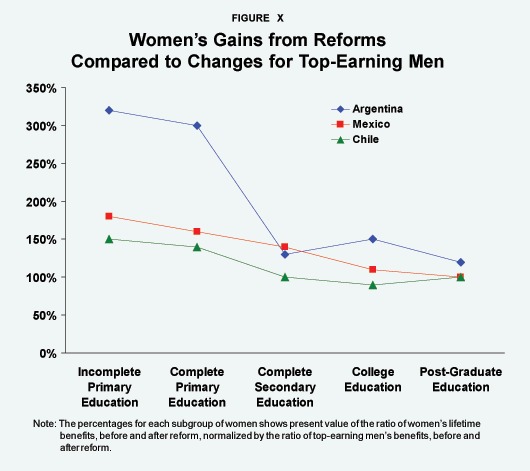
"Women and low-income workers gained the most from reforms."
Gains Relative to High-Earning Males. We compared the change in benefits for men and women with different levels of education with the change experienced by men in the top educational category. We found that workers in the lower educational categories gained more and that women gained most. As we have seen, the public benefits redistribute income toward retirees with lower incomes, many of whom are women. Women also gain from the joint annuity requirement. As a result, women in all education groups gain, relative to men in the highest education category. As Figure X shows:
- In Chile, the ratio of postreform to prereform lifetime benefits for the average married women with a primary or incomplete secondary education was 40 to 50 percent more than that for married men in the highest educational category.
- In Argentina the ratio was 200 percent higher and in Mexico 60 to 80 percent higher than those for best-educated men.
Men in the bottom educational groups also made relative gains, but not so large as women.
Appendix II discusses in greater detail each source of retirement income and how it affects women versus men. For simulation results for all educational, marital and labor force participation groups, see the Appendix Tables.
[page]Individual account systems can improve relative outcomes for women and have done so in Latin America. But the relative gains to women are not inevitable; detailed design features matter. We can draw lessons from the three countries' experiences so as to improve the gender outcomes of a new multipillar system in the United States.
Social Safety Net. The purpose of the individual account is to require people to save for their own old age, while the safety net aims to redistribute income to those with a low capacity to earn and save. The progressivity of the current Social Security system in the United States is limited by lower expected lifetimes for low earners, a ceiling on taxable earnings for high earners, the absence of a minimum benefit and the presence of idiosyncratic redistributions. Reform provides an opportunity to strengthen the safety net and target redistributions more carefully. As in Latin America, low-earning women likely would benefit – if we do it right.
"Working women in the United States would benefit from personal accounts, low-earning women would benefit from minimum guarantee, and married women would benefit from joint annuities."
Annuitization. Annuitization, which provides a guaranteed income for life, is especially important for women in view of their greater longevity. This requirement – at least up to the poverty line – could be built into the individual account system. In Latin America lump sum withdrawals are allowed only for the amount left over after the retiree has purchased a pension that exceeds a specified floor.
Indexation of Annuities. Inflation insurance is especially important to women for similar reasons; otherwise the purchasing power of their pensions will fall substantially as they age. In the old Latin American systems, pension benefits were not price-indexed. This situation is changing in the new systems. During the accumulation stage account balances grow with the rate of interest, which is generally greater than the inflation rate. During the payout stage, annuities are price-indexed in Chile, and Mexico plans to begin price-indexing. This is facilitated in Chile by the prevalence of indexed bonds and other financial instruments. It will be more difficult and costly in Mexico because of the paucity of indexed instruments. The existence of long-term price-indexed bonds makes indexed annuities feasible and advisable in the United States.
Joint Pensions. Women often have low years of market work as part of an informal family contract in which the husband supports the wife in exchange for the time she spends caring for the family. In Latin America this contract is enforced by requiring that husbands purchase survivors' insurance before retirement and joint pensions upon retirement. This is an important requirement to build into any individual account system. An added bonus of joint annuities is that they defuse the contentious unisex issue. When purchasing individual annuities, unisex mortality tables produce higher payouts for women and lower payouts for men as compared with gender-specific tables, but in the case of joint annuities the choice of mortality tables makes very little difference. Since joint annuity pricing takes into account the combined lifetimes of husband and wife, similar monthly and lifetime payouts are produced whether unisex or gender-specific mortality tables are used.
"American women should be allowed to keep annuities based on their own earnings in addition to a joint annuity from their husband's personal account."
Own-Annuities and Joint Annuities – either or both? Financing spousal and widows' benefits from the common pool raises tax rates and penalizes working women and single men and women.16 In the United States and many other countries, working women must choose between their own benefit or the widow's benefit – they can't get both. Thus, women who work in the market for much of their lives pay substantial taxes with no incremental benefit. In contrast, in the new Latin American systems the widow keeps her own annuity as well as the joint annuity, which is financed by the husband. Market work by the wife is rewarded rather than penalized, yet this does not impose an additional burden on the public treasury.
Accounts and Annuities in Divorce or Cohabitation. At present the divorce rate is low in Latin America and divorce is prohibited in Chile (although marriages can be "nullified"). Thus, the systems we are analyzing do not contain detailed mechanisms for handling assets in or payouts from individual accounts in case of divorce. Legal protections regarding retirement accumulations and annuities would obviously be needed in the U.S. for divorced women and women cohabiting without formal marriage. These might include, for example, treatment of pension assets acquired during the marriage as community property in case of divorce and for legally recognized partnerships.17
Investor Education. Some evidence from the United States and other countries indicates that women may choose lower-risk portfolios with lower expected rates of return than men, in which case their accumulations and annuities would be lower, leading to a lower gender ratio. In Latin America little portfolio choice has been available until recently, so this issue has not arisen, but that is now changing in Chile, which will have to face the possibility of systematic differences in investment choices by gender and socioeconomic groups. The MPG, which sets a floor on pensions, will help to counteract excessive risk aversion among low earners. Investor education is essential so that women do not dissipate the gains from the new system by making overly conservative investment choices.
"Currently, Social Security provides a higher rate of return to nonworking married women than to single women or women who work."
Public Benefits for Working versus Nonworking Women. Women can have low lifetime earnings because they receive low wage rates or because they work few years. Should both these groups be considered equal targets for redistribution through the public pillar? Chile does not distinguish between these two causes in determining eligibility for its MPG, but Mexico does in allocating its SQ. In the current U.S. system, a higher rate of return is provided to those with low lifetime earnings, providing they have worked at least 10 years. The U.S. formula does not distinguish between people who have worked a little at high wage rates versus those who have worked a lot but earned low rates. Studies have shown that often the low earnings are due to low years of work rather than low wage rates.18 Furthermore, married women get a spousal benefit even if they have never contributed but single women must work to secure a benefit. Given two households with the same family income, the one with a wife who stayed at home gets a larger total benefit and pays lower payroll taxes than the one where both husband and wife worked in the labor market. We need to think through whether we are satisfied with this formula.
Indexation of the Public Benefit. Our simulations for Chile showed that if the MPG is price-indexed it becomes almost irrelevant in the future as wages and own-annuities grow in the face of a constant MPG. It will then be ineffective as a gender-equalizing instrument. This is part of the reason why very few pensioners receive the MPG in our simulations. In reality, the MPG has been increased on an ad hoc basis with wages over the past 20 years and is currently received by many women (as well as men). But a wage-indexed MPG is costlier and produces larger work disincentives than a price-indexed or nonindexed MPG. Similar issues arise in the debate over social security reform in the United States. One of the three proposals of the President's Commission to Strengthen Social Security would price-index the public benefit, instead of wage-indexing it for new cohorts, as is done now. A public benefit indexed to inflation would eventually become smaller relative to the average pension and the average wage and would therefore afford less protection to future cohorts of women and other low earners. An alternative proposal by the Commission would index the public benefit half to wages and half to prices, in order to maintain its relevance through time. But this implies a higher cost. Policy makers and citizens will have to evaluate this trade-off.
How we design our individual account system is up to us. The Latin American experience shows that a careful design will improve the position of women while also making our system more financially sustainable.
NOTE: Nothing written here should be construed as necessarily reflecting the views of the National Center for Policy Analysis or as an attempt to aid or hinder the passage of any bill before Congress.
[page]Analysis of how women fare relative to men in the new and old social security systems is difficult for a number of reasons. First, the new systems have not been in effect long enough to be mature. That is, current retirees are subject to a mixture of old and new system benefits and we cannot be sure how someone fully under the new system will fare in the future. Moreover, we don't know the future rate of wage growth and rate of return on investments, which determine retirement accumulations. At the same time, longitudinal data from the past are not available. Thus we could not use actual employment histories of current retirees and workers to estimate their benefits under the new systems.
Representative Men and Average, Full-Career and 10-Year Women. We solved these problems by constructing synthetic men and women – using cross-sectional data on current behavior of people at different ages, educational levels and marital status to proxy the lifetime employment, wage and contribution histories of "typical" persons in each category. We then simulated how the average man and woman in each educational category would fare under the rules of the old and new systems, given these histories. Five educational levels are presented, ranging from incomplete primary to several years of postsecondary. We use education as a proxy for "potential permanent income."
This methodology assumes that age-specific labor force participation and wage behavior will remain constant through time, except for secular wage growth, for each schooling level. In reality, aggregate female labor force participation rates have been rising and will probably continue to rise. Female labor force attachment is strongly positively correlated with education levels, which have been rising dramatically. Changing social norms may lead to additional increases in female employment probabilities within each educational category. Moreover, the work incentives and disincentives in the new pension systems may alter work habits.
These potential changes in female labor force participation rates were not taken into account directly. However, in addition to the "average" woman in each educational group, we also calculated pensions for "10-year women" who work only 10 years, prior to childbearing and for "full career women" who have the same labor force participation and retirement age as men. Full career women give us an indication of the impact of increasing female labor force participation rates. The absence of longitudinal data meant that we could not vary wages as a function of experience, so the lifetime earnings and pensions of full career women are probably understated.
Our married men and women are assumed to be single until the median age of marriage in each country, and married thereafter. They marry within their educational class, and the average husband is three years older than the wife. We use the same wage and work profiles for single women, because of the small sample size for singles in the older age-higher education cells. Since single women probably have greater labor force attachment than married women, our simulations for full career women give us a rough approximation of their lifetime earnings and benefits. Thus, altogether we model five categories of men by education grouping and 15 categories of women – five education groups and three levels of labor force attachment – as well as distinctions by marital status for both genders. In constructing our synthetic men and women, we use national data sets for urban areas.18
Assumptions for Simulations. We use these employment histories to simulate the accumulations, annuities and public benefits that different groups of men and women can expect under the new and old systems. Accumulations and annuities in individual accounts are very sensitive to rates of return on investments and rates of wage growth. In our baseline simulations, we assume a "moderate growth" scenario in which economy-wide real wage growth is 2 percent per year and the real rate of return is 5 percent prior to retirement. The return during the payout stage is assumed to be 4 percent, given the likelihood that many will choose a lower-risk or fixed-rate annuity.19 Sensitivity analyses assuming a 3 percent real rate of return during the accumulation stage, 2 percent during annuitization and a 0 rate of wage growth were also carried out. The gender results in this "slow growth" case are very similar to the baseline, except that the relative role of the public benefit increases dramatically, especially in Chile, and therefore gender ratios are compressed. In this paper we focus on the baseline case, which produces less favorable gender results from the new systems.20
Differences in Investment Returns. Some evidence from the United States and other countries indicates that women may choose less risky portfolios with lower expected rates of return than men, in which case their accumulations and annuities would end up lower, leading to a lower gender ratio. However, in Latin America limited financial markets and regulations have given workers little portfolio choice. They can choose an asset manager, but all managers offer very similar portfolios. Thus, gender differences in portfolio risk and return are minimized. This may change, as Chile in 2002 started allowing differentiated portfolios and other countries may follow suit. For the United States, we simply note that any observed gender differentials are reduced once earnings differentials are controlled and may disappear once women acquire more financial experience. Moreover, the differential return would be much smaller if measured in risk-adjusted terms.21
Annuitization at Retirement. Although both gradual withdrawals and annuities are permitted at the payout stage, to impute a stable annual flow for purposes of analysis we assume that these accumulations are fully annuitized upon retirement. For simplicity in calculating the value of the annuity, we assume that these average people all have a certain lifetime, which corresponds to the national expected life spans. Life expectancies are differentiated by country and gender. Based on analyses of annuity markets in Chile and other countries, we assume a "money's worth ratio" of 100 percent, using a low-risk discount rate.22 Men and women are assumed to retire at the retirement age that is specified in each country – lower for women than for men in Chile and Argentina. In fact, in Chile most men retire from the system 5 to 10 years earlier than the "normal" age, which narrows the gender gap in pensions relative to that presented in this paper.
Present Value of Lifetime Benefits. Although we start by comparing monthly benefits, for the analysis of transfers and systems we shift to a comparison of lifetime benefits, since retirement ages changed as a result of the reforms, expected age of death varies by gender and country, and benefits from the joint annuity start flowing to widows late in old age. We calculate present value of lifetime benefits as of age 65, discounting at the same rate used for annuitization – 4 percent in our baseline case, 2 percent in the slow growth case.
Imputed Taxes and Net Public Benefits. We know each person's contribution to the individual account. However, often we don't know the future cost of the public benefit, its intergenerational burden or its gender incidence, since this is financed, in whole or part, out of general revenues. Our analyses of net redistributions (gross benefits minus taxes) are based on the simplifying assumptions that each cohort covers its own bill and that, within each cohort, the tax burden is distributed proportionally to lifetime earnings as proxied by lifetime annuities from the worker's own retirement accumulation.
The Counterfactual for System Comparisons. Comparing the new versus the old systems introduces an additional set of methodological problems. The old systems were actuarially unbalanced so could not have delivered their promised benefits. What, then, is the counterfactual to the new system? To handle this problem we focus on relative rather than absolute gains and losses to different gender-education-marital groups. Implicitly, this means we are comparing the reform with a counterfactual in which the fiscal imbalance of the old system is corrected in a distributionally neutral way – involving equi-proportional benefit cuts or tax increases for each group, while leaving relative positions unchanged.23 We also compare the old and new gender ratios to see whether these ratios improved or deteriorated due to the reform. [See Appendix Table VI.] In our comparisons of post- and prereform positions across educational groups, we normalize each group's ratio according to the ratio for men in the top educational group. [See Appendix Table VII.] Thus, we are measuring whether a particular group improved its position relative to highly educated men (and relative to each other); we are not measuring absolute gains or losses.
Description of Old Systems. In general, the old systems provided a benefit of the following sort:
B = aYS, where:
B = annual pension benefits, a = incremental benefit per year of work, Y = number of contributory years, S = average salary during last few years of work.
This formula provided a generous benefit for women who worked for only a short time and then withdrew from the labor market, because a was often very high for the first 10 years of work.24 Thus, in all three countries, the first 10 to 20 years of contributions produced a high replacement rate. Women were more likely than men to work for 10-20 years and then leave the formal labor market. Married women got a widow's benefit that was 50 percent of their husband's pension in Chile, 75 percent in Argentina and 90 percent in Mexico. Implicitly, unisex tables were used. Women could retire five years earlier than men with no actuarial penalty in Chile and Argentina. In Mexico a minimum pension protected low earners. All of these provisions favored women.
However, the old systems based their benefits on the last few working years, which favored men. A woman who worked at ages 20 to 30 before childbearing would earn no interest on her contributions and would find her pension based on wages that would appear to be very low compared with prevailing wages when she retired at age 60 to 65. (For example, with 2 percent real wage growth per year the average real wage rate would have doubled over that period.) In addition, using final years' salary as the reference wage especially favored workers with steep age-earnings profiles, who tended to be highly educated men. Furthermore, in Chile and parts of the Argentine system, a woman had to give up the earned pension to get the widow's pension, so women who worked much of their lives in the labor market got little or no incremental benefit from their contributions. Finally, the failure of the old systems to index for inflation was a major disadvantage to all workers, but especially to women. Pensionable salaries were based on past wages that were usually not indexed for inflation. Once a person retired, the initial benefit was usually not indexed for inflation. Yet these countries had such high levels of inflation that often their pensions were worthless. Ad hoc adjustments always lagged the pace of inflation. This especially hurt women who had worked for wages long in the past and received pensions long into the future.
The new systems eliminated these biases, both pro and con women. As discussed above, a woman keeps her own benefit as well as the widow's benefit from the joint annuity. The new public pillars are tilted toward low earners, who are predominantly women. Contributions to the individual accounts that are made in early adulthood add more to present value of lifetime benefits than contributions made in the final years, since the financial instruments in which they are invested generally earn a positive real rate of return over long periods. In Mexico the public benefit is price-indexed, in Chile it has been increasing faster than prices, on par with wages, and in Chile private annuities acquired upon retirement are price-indexed. How women versus men have fared given these complex changes is the empirical issue we have attempted to untangle.
[page]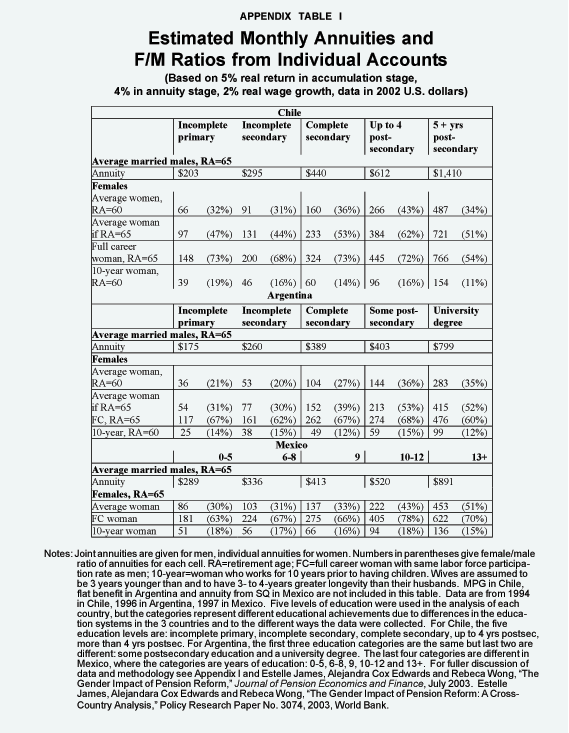
Under the new systems in Chile, Argentina and Mexico, women receive retirement income from three sources: own annuities, joint annuities and a public benefit. In the following discussion, we consider the relative impact of each source for different subgroups of women: by education, labor market participation and marital status. All values in this paper are expressed in 2002 U.S. dollars.
Impact of Own-Annuities from Personal Accounts. The average woman ends up with an own-annuity that is approximately the same relative to male annuities in Chile and Mexico – 30 percent to 45 percent that of the average man – and less than 30 percent in Argentina. [See Appendix Table I and Figure I.] These ratios rise at higher educational levels because of the positive correlation between education and female labor force participation.
Despite its lower female labor force participation rate, Mexico jumps ahead of Argentina and on par with Chile because it has decreed equal retirement ages (65) for men and women. If the retirement ages were equalized in Chile and Argentina, the monthly annuity of women would rise almost 50 percent, even with work experience unchanged, because interest would accumulate for five years more and the annuity would be paid for five years less. But even full career women who work as much and retire at the same age as men get only 65 percent to 75 percent as much as men because of large wage disparities.
Impact of the Public Benefit. Disparities in annuities funded by personal accounts are narrowed by transfers through the public pillar – the minimum pension guarantee (MPG) in Chile, the social quota (SQ) in Mexico and the flat pension in Argentina. [See Appendix Table II and Figures VII, VIII and IX.] Women who receive the public benefit end up well above the poverty line. These transfers raise the female/male ratio of total retirement income and produce a higher rate of return on contributions for women than for men.
Low lifetime earnings may stem from low wage rates or low work experience. In the United States, our progressive defined benefit formula gives a higher return to those with low lifetime earnings, but studies have shown that often the low earnings are due to low years of work rather than low wage rates.26 Policy makers thus face a trade-off between equalizing benefits and reinforcing work incentives. Each of our three Latin American countries has chosen a different way to deal with this trade-off.
Chile's Minimum Pension Guarantee (MPG). The MPG is targeted toward low earners, but it discourages further contributing work by those who have met its eligibility requirements.
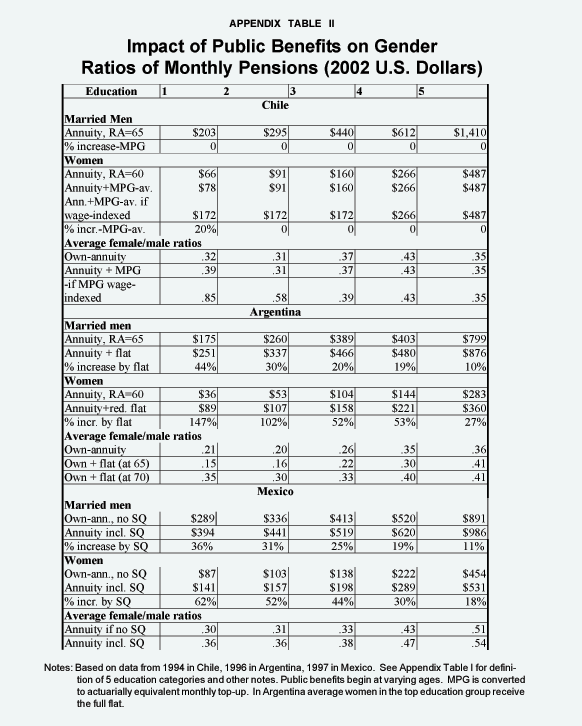
The MPG as an income floor. The MPG sets a floor on the real value of pensions of qualifying workers. The MPG floor in 1994 was $78 per month, about 27 percent of the average male wage, 37 percent of the average female wage and 125 percent of the poverty line at that time. If the worker's own annuity is less than the MPG, the government tops it up to the minimum level.27
The MPG as insurance against partial labor force attachment and deterrent to postponed retirement for low earners. The MPG does not cost very much, because it is narrowly targeted. Chile requires at least 20 years of contributions for eligibility; this limits the number of eligible workers and the size of the requisite top-up. Since the average male worker in every educational category is projected to accumulate an own-annuity far above the floor set by the MPG, he never needs a top-up. In contrast, the average female with primary education or less gets a small top-up to her own-pension from the MPG (equivalent to 18 percent or $12 monthly), which helps to narrow the gender gap for low earners. Most women with secondary education or more have own annuities that exceed the MPG. Raising the number of years for eligibility to 25 or the female retirement age to parity at 65 would bring the own-annuities of almost all qualifying women above the MPG level so they would lose the MPG top-up for their entire period of retirement. Current rules discourage additional work or postponed retirement by low-earning women.
Wage versus price-indexation of MPG. These projections are based on the assumption that Chile's MPG retains a constant purchasing power through time, as with price-indexation. This means that it will gradually decline relative to rising wages and own-annuities – part of the reason our simulations show it to be received by only a small proportion of pensioners. However, in fact the MPG has kept pace with wage growth through ad hoc increases. By 2002 it had reached $105 for pensioners below age 70 and $114 for pensioners above age 70. If ad hoc wage indexation continues, it will reach $172 (in 2002 dollars) by the time young workers retire. A much broader group of women (and even some men), extending through the secondary education level, would then receive a top-up. The top-up for women in the lowest educational category would rise from $12 to $106 monthly. This would decrease the gender gap considerably but it would cost much more than a price-indexed constant value MPG and would further reduce the incentive to work and contribute beyond 20 years.
Argentina's Two-Tiered Flat Benefit. Most women are not eligible for the full public benefit in Argentina because of the long work history required for eligibility.
Eligibility for the full flat benefit – not for women. Argentina pays a flat monthly benefit of $77 (in 2002 U.S. dollars) as an add-on rather than a top-up to the worker's own pension. It is about 30 percent of the average male wage, 45 percent of the average female wage and 130 percent of the poverty line. Thirty years of contributions are required for eligibility. Most men in all educational categories meet this requirement and receive this benefit, starting at age 65. Because it adds a substantial constant amount to a disparate contribution-based annuity, it is very effective at equalizing pensions between high- and low- earning men. However, most women are ineligible for this flat benefit because they work less than 30 years – except for those with a university degree, who can begin receiving the full flat benefit at age 60. This is the converse of the eligibility situation in Chile.
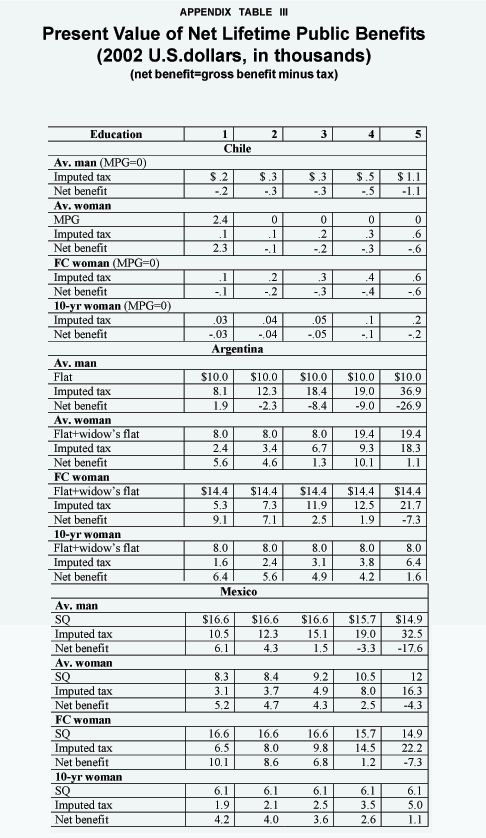
Reduced basic benefit for women. Most women are eligible for a reduced basic benefit of $54 at age 70, which accrues to workers who have more than 10 years of contributions. Although small in absolute terms, compared with the woman's own wage and annuity benefit it is quite large. It doubles the monthly pension of the average woman with less than secondary education and trebles the monthly pension of women with incomplete work histories (the "10-year woman") at age 70. This leads to a sharply contrasting situation between women at ages 65 and 70: at age 65 the female/male ratio of monthly pension is much lower than in Chile or Mexico, but at age 70 it jumps up to the same range as Chile and Mexico – with the added cost borne by the public sector.
Discontinuous link to years worked. Argentina's attempt to extend a minimum benefit to all, while also rewarding work to some extent, leads to puzzling pattern of work (dis)incentives. Women face a large reward for working 10 years in the formal labor market, but no marginal benefit from contributing to the public pillar over years 10-29; but if they work 30 years, they receive the full flat public benefit. Argentine policymakers are now considering eliminating the reduced flat benefit or linking it more continuously to years of service.
Mexico's Social Quota. The Social Quota (SQ) – a uniform payment by the government into each worker's individual account, per day worked – is 5.5 percent of the minimum wage (initially 1.8 percent of the average male wage and 2.6 percent of the average female wage) for every day worked. Thus it is roughly a one-third match to the average-wage worker's contribution to the private pillar. It should produce an annuity that is about 10 percent of the average wage for the full career worker. It provides greater work incentives than the public benefits in Chile or Argentina.
Mexico also has an MPG, but 25 years of contributions are required for eligibility. Most men have an own-annuity that exceeds the MPG while many women don't. However, the average woman in all educational categories fails to accumulate enough years of contributions to be eligible.
Distributional Effects of the Public Benefits. Differences in the design of the public pillars in these three countries have quite different distributional effects on subgroups among women, and formal work is rewarded differently.
Lifetime Net Benefits. Measuring the present value of public benefits and lifetime taxes used to cover these benefits, to the point at which the individual reaches age 65, we find that low earners, and especially women, receive net benefits in all three countries. Furthermore, imputed taxes are lowest and the subsidy is largest for women in the lowest educational categories. [See Appendix Table III. Also see Appendix I for discussion of imputed taxes.]
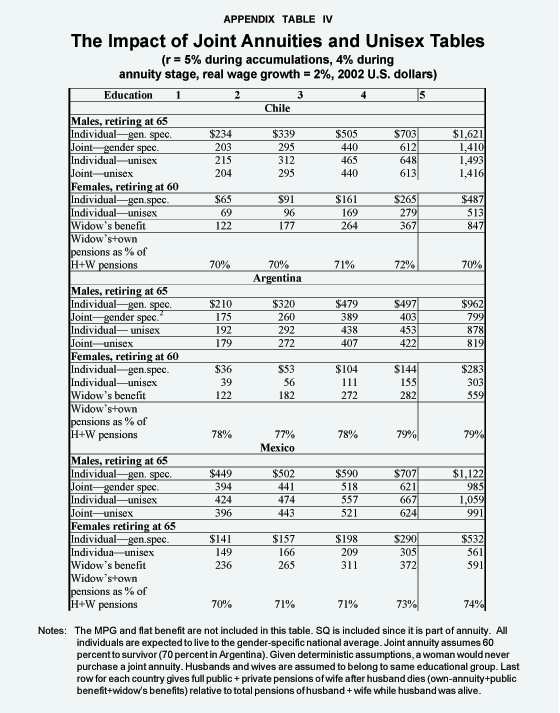
Effects of Labor Market Experience. Benefits from the individual accounts are directly linked to work and contributions in all three countries. But the public pillars reward formal labor force attachment quite differently. Mexico offers the most consistent rewards for work, since the SQ payment is proportional to days worked. Full career women who retire at 65 get the largest lifetime net transfers. In Chile work is strongly encouraged by the low tax cost of the MPG, but lifetime benefits from the public pillar decline for women who work more than 20 years or postpone their retirement beyond age 60. In Argentina a substantial net subsidy goes to women who work only 10 years, financed by taxes on high-earning men and full career women. The work disincentives from the flat public benefit and high taxes in Argentina partially offset the positive work incentives stemming from the individual accounts.
Intra-Household Transfers from Joint Annuities. In all three countries, the largest impact on lifetime pension benefits by gender stems from private intra-household transfers from husbands to wives through the joint pension. For most subgroups these transfers are much larger than those through the public pillar. [See Appendix Tables IV and V.]
Survivors' Benefits while Husband Is Working. In countries with traditional defined benefit systems, such as the United States, survivors' benefits to widows are paid out of the common pool and are usually 50 to 100 percent of the husband's potential benefit. This means that married households are subsidized by singles, regardless of income. In contrast, in the new Latin American multipillar systems, working husbands are required to purchase survivors' insurance for their wives, in place of this inter-household subsidy. A small amount of the total contribution (less than 1 percent of payroll) is used for this purpose.
Joint Annuities after Retirement. All three countries require husbands to purchase joint annuities (or take gradual withdrawals spread over both lives) when they retire. This creates a widow's benefit. In Chile and Mexico the survivor gets at least 60 percent, and in Argentina the survivor gets 70 percent of the primary benefit. The joint pension is a way to extend beyond the husband's death an informal family contract in which wives stay out of the labor market to provide services at home, and in return husbands support them monetarily. The average widow's benefit after the husband's death is greater than her own-pension, and it adds 30 to 70 percent to her own-annuity on a lifetime basis.28 [See Appendix Table Va Vb.]
The joint pension is especially important because a widow's cost of living is estimated to be roughly 70 percent of a couple's cost, due to household economies of scale. The widow's benefit plus her own benefit maintains household purchasing power at 70 percent to 80 percent of the previous level, so her standard of living is unchanged. The joint annuity also protects women who did not work at all in the formal market. The joint pension requirement may crowd out voluntary savings and insurance purchases in some households. However, there is little "crowd-out" effect for the many couples who do not save. Empirical evidence indicates many families do not save and insure enough to smooth lifetime consumption of all members.29
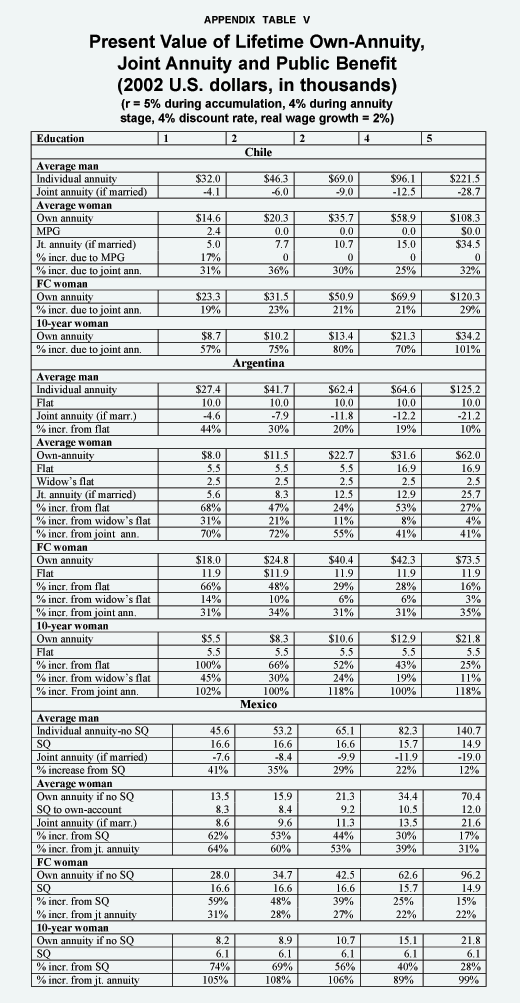
The joint pension requirement raises the female/male ratio of total lifetime benefits until it reaches 60 percent to 90 percent for the average married woman and 100 percent or more for full career married women. [See Appendix Table VI and Figures IV through IX.] Full career single or divorced women or those cohabiting without a formal marriage, who do not get the joint pension, are estimated to have lifetime benefits that are 70 percent to 80 percent those of single men. [See Appendix Table VI.] Comparing the old and new gender ratios, we find that these improved due to the reforms in almost all cases, especially for married women. [See Appendix Table VI.]
Women Receive Both the Joint Annuity and Their Own-Annuity. Survivors' benefits after retirement are included in traditional social security systems. However, in the United States and most other countries, when a husband dies, the wife must choose between keeping her own benefit or the widow's benefit. In the new Latin American systems, the husband rather than the government pays the widow's benefit through the joint annuity. Since this is viewed as his property while the annuity the widow gets from her own contributions is her property, she is allowed to keep both. This allows her to maintain her living standard and encourages her to work, without imposing an additional burden on the public treasury.
As a result of these three sources of benefits, gender ratios improved after the reform and simulations show that the biggest gainers will be women with low levels of education (Appendix VI and VII).

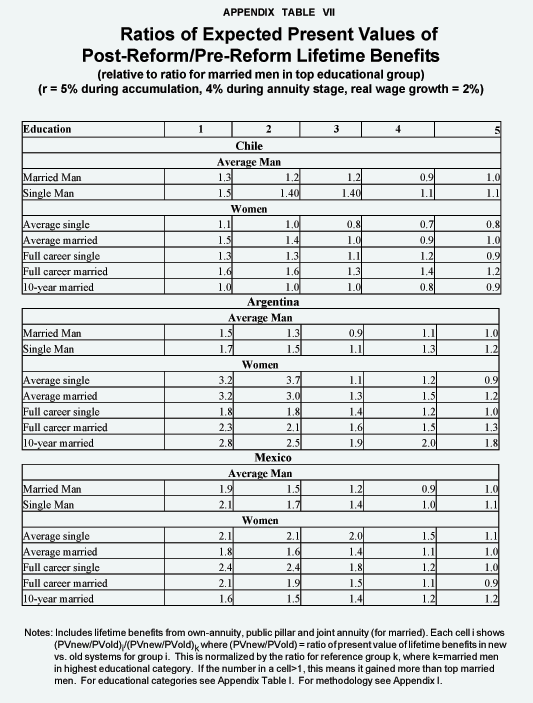
- This paper is adapted from Estelle James, Alejandra Cox Edwards and Rebeca Wong, "The Gender Impact of Pension Reform," Journal of Pension Economics and Finance, July 2003. It is part of a joint project carried out by James, Cox-Edwards and Wong, financed by the Economics and Gender Trust of the World Bank. For earlier papers coming out of this project, see Alejandra Cox Edwards, "Gender-Differentiated Effects of Social Security Reform: the Case of Chile," The World Bank Economic Review, Vol. 16, No. 3, 2002; Alejandra Cox Edwards, "Social Security Reform and Women's Pensions," Policy Research Report on Gender and Development, Working Paper Series No. 17, 2001, World Bank; Alejandra Cox Edwards, "Gender Inequities in the Pension and Social Protection Systems in the Region," presented in Santiago, Chile, in conjunction with the Annual Meeting of the Board of Governors of the Inter-American Development Bank and the Inter-American Investment Corp., 2001; Susan Parker and Rebeca Wong, "Welfare of Male and Female Elderly in Mexico: A Comparison," in The Economics of Gender in Mexico: Work, Family, State, and Market (Washington, D.C.: World Bank, 2001); Rebeca Wong and Susan Parker, "Social Security Reform in Mexico: A Gender Perspective," paper presented at the Population Association of America Meetings, Washington, D.C.; and at the Interamerican Conference on Social Security, Brazil, 2001. For an expanded version see Estelle James, Alejandra Cox Edwards and Rebeca Wong, "The Gender Impact of Pension Reform: A Cross-Country Analysis," World Bank, Policy Research Working Paper 3074, 2003. We thank the Economics and Gender Trust Fund at the World Bank for support on this project.
- Other papers have discussed the projected income replacement rate for men and women in Chile and Argentina, but none have used actual labor market behavior to simulate employment histories and compare expected benefits under the new and old systems. See Fabio Bertranou, "Pension Reform and Gender in Latin America: Discussion of Relevant Issues," Working Paper, 1998, World Bank; Fabio Bertranou, "Pension Reform and Gender Gaps in Latin America: What Are the Policy Options?" World Development, Vol. 29, No. 5, 2001; and A. Arenas de Mesa and V. Montecinos, "The Privatization of Social Security and Women's Welfare: Gender Effects of the Chilean Reform," Latin American Research Review, Vol. 7, No. 37, 1999.
- The poverty rate of women over age 65 is 15 percent, compared with 7 percent for men over age 65. The poverty rate for women over age 85 is 20 percent. For divorced, separated or never-married elderly women the poverty rate is 27 percent. See Ekaterina Shirley and Peter Spiegler, "The Benefits of Social Security Privatization for Women," SSP No. 12, Cato Institute, Washington, D.C., 1998. See also Debra Street and Janet Wilmoth, "Social Insecurity? Women and Pensions in the United States," in Jay Ginn, Debra Street and Sara Arber, eds., Women, Work and Pensions (Buckingham: Open University Press, 2001).
- Ginn, Street and Arber, eds., Women, Work and Pensions.
- U.S. General Accounting Office, Social Security Reform: Implications for Women's Retirement Income. GAO/HEHS-98-42, 1997, Washington, D.C.
- For tables on work and wage histories of men and women by education, see Estelle James, Alejandra Cox Edwards and Rebeca Wong, "The Gender Impact of Pension Reform: A Cross-Country Analysis," World Bank, 2003.
- Ginn, Street and Arber, eds., Women, Work and Pensions.
- U.S. GAO, Social Security Reform: Implications for Women's Retirement Income.
- Richard Posner, Aging and Old Age (Chicago: University of Chicago Press, 1995), pages 139, 277.
- All data on administrative and insurance costs are from Estelle James et al., "Mutual Funds and Institutional Investments: What Is the Most Efficient Way to Set Up Individual Accounts in a Social Security System?" in John Shoven, ed., Administrative Costs and Social Security Privatization (Chicago: University of Chicago Press, 2000); and Estelle James, James Smalhout and Dimitri Vittas, "Administrative Costs and the Organization of Individual Account Systems: A Comparative Perspective," in R. Holzmann and J. Stiglitz, eds., New Ideas About Old Age Security (Washington, D.C.: World Bank, 2001). Also see Private Pensions Series No. 2: Administrative Costs and Reforms (Paris: Organization for Economic Cooperation and Development, 2001).
- Chile also offers a noncontributory social assistance program called PASIS, which pays about 50 percent of the MPG, funded out of general revenues. This is designed to keep out of poverty the elderly who are not eligible for contributory benefits. The vast majority of its recipients are women living in rural areas. The number of eligible applicants exceeds the available money, so a long waiting list has developed.
- In Argentina the new system is being reexamined as a result of the nation's fiscal crisis, and some modifications will probably be made in the near future. The old system, too, changed frequently, and was not always implemented as written, and several regimes existed. We base our analysis and discussion on the new system as currently written and the old system as written, for the main regime, shortly before the reform. This version of the law did not permit women to keep their own benefit while getting the widow's benefit.
- Here the worker has a choice between a public defined benefit pillar (called PAP) that is a downsized version of the old public system, and a private pillar that is similar to the Chilean model. PAP is available only to workers with more than 30 years of contributions; workers who contribute for less than 30 years lose all their contributions – so the PAP is particularly inappropriate for women. As of 2001, over 80 percent of all contributors, including most women, were in the private rather than the public second pillar. Consequently, in this paper we focus on the private option.
- If 30 percent of all workers get the MPG and the top-up from the public pillar is 33 percent of the lifetime guaranteed level for these workers, the MPG costs only 10 percent as much as a flat benefit, where both are set at the same percentage of the average wage and have the same contributory requirements. For example, if a flat benefit that is 25 percent of the average wage costs 12.5 percent of payroll, a minimum pension guarantee that is 25 percent of the average wage will cost only 1.25 percent.
- INFONAVIT historically provided a negative real return, but the hope of the reformers was that this would change in the future. In our simulations we assume a 0 real return.
- In the United States, a spouse over the age of 65 receives a benefit that is 50 percent of her husband's benefit, even if she hasn't worked and contributed, and after he dies she gets 100 percent of his benefit. This means that married couples receive larger benefits than (and are subsidized by) singles with the same total earnings, and couples with the same total earnings with one wage-earner get larger benefits than (and are subsidized by) couples in which both husband and wife work. Furthermore, the nonworking wife in a single-earner family gets a larger benefit than the wife in a dual earner family with the same total family income. For examples, see Ekaterina Shirley and Peter Spiegler, "The Benefits of Social Security Privatization for Women."
- In the current U.S. Social Security system, divorced women are protected only if married for at least 10 years. If individual accounts in a reformed system were treated as community property, assets that accumulated during the marriage would be split between the two parties, regardless of how long the marriage lasted.
- Julia Lynn Coronado, Don Fullerton and Thomas Glass, "Distributional Impacts of Proposed Changes to the Social Security System," in J. Poterba, ed., Tax Policy and the Economy, Vol. 13, 1999, pages 149-86; Julia Lynn Coronado, Don Fullerton and Thomas Glass, "The Progressivity of Social Security," NBER Working Paper W7520, 2000, National Bureau of Economic Research; Alan Gustman and Thomas L. Steinmeier, "How Effective Is Redistribution under the Social Security Benefit Formula?" NBER Working Paper W7597, 2000, National Bureau of Economic Research.
- The Chile estimates are based on CASEN 94, a nationally representative household survey. The estimates used are based on the urban sample – approximately 100,000 individuals age 16 or older. The Argentine data are based on the micro data set of the Encuesta Nacional de Gastos de los Hogares (ENGH) for 1996-1997, a nationally representative household survey from urban areas. The sample contains 103,858 individuals, of whom 69,895 were 16 years or older. The Mexican data come from the 1997 Mexican National Employment Survey (ENE-97) completed by INEGI (Instituto Nacional de Estadística, Geografía e Informática), the Mexican Statistical Bureau. The sample contains information on 119,405 individuals aged 12 or older. We use the sub-sample corresponding to more-urban areas (communities of 100,000 people or more), which is about 78 percent of the sample. For more details on data sets, potential data problems and construction of tables, see James, Edwards and Wong, "The Gender Impact of Pension Reform." James, Edwards and Wong, "The Gender Impact of Pension Reform: A Cross-Country Analysis."
- See Estelle James and Xue Song, "Annuities Markets around the World: Money's Worth and Risk Intermediation," CeRP Working Paper 16/01, 2001, Center for Research on Pensions and Welfare Policies.; Estelle James, Dimitri Vittas and Xue Song, "Annuities Markets in Comparative Perspective: Do Consumers Get Their Money's Worth?" paper presented to the American Economic Association, 2001.
- For details on the slow growth case, see James, Edwards and Wong, "The Gender Impact of Pension Reform: A Cross-Country Analysis."
- For a summary of the U.S. literature on this topic, see U.S. General Accounting Office 1997; Kathy Burnes and James Schulz, "Older Women and Private Pensions in the United States," 2000, National Center on Women and Aging, Brandeis University; Shirley and Spiegler, "The Benefits of Social Security Privatization for Women."
- Estelle James, Dimitri Vittas and Xue Song, "Annuities Markets in Comparative Perspective: Do Consumers Get Their Money's Worth?"; James and Song, "Annuities Markets Around the World: Money's Worth and Risk Intermediation,"; Estelle James, Guillermo Martinez and Augusto Iglesias,"Payout Choices by Retirees in Chile: What are They and Why?" working paper draft, 2003.
- In reality most adjustments to insolvency have not been distributionally neutral. For example, inflation with indexation applied only to a minimum pension hurts high earners and men disproportionately, while raising the payroll tax rate subject to a fixed maximum hurts low earners, and equalizing retirement ages for the two genders hurts women, especially in a defined benefit plan. We have no way of knowing which adjustments would have been chosen in these three countries if they had not shifted to a multipillar structure.
- In Chile, a = 5 percent for each of the first 10 years and 1 percent per year thereafter up to a maximum replacement rate of 70 percent, so the old system paid 50 percent of pensionable salary for the first 10 years of work. The pensionable salary was the average of the last five years of work, of which the last three years were indexed for inflation. Pensions began at age 60 for women, 65 for men. In Argentina, the old system paid: a) 70 percent of base salary for 20 years of contributions plus an additional 1 percent for every year over 30, or b) 50 percent of base for those who worked only 10 years, plus an additional 1 percent for every year over 10. In both cases, base salary was defined as the best three out of 10 years. Workers qualifying for (a) could retire early at age 60 for men, 55 for women, but (b) started at age 65. In Mexico, the old system paid a proportion of the base salary for the first 10 years plus an increment for every year over 10, where the base salary was the average of earnings during the last 250 working weeks. The proportion of base varied negatively with wages, ranging from 13 percent for high earners to 80 percent for low earners. The accrual rate for additional years varied positively with wages, ranging from .56 percent to 2.45 percent per year. Moreover, the monthly pension was paid for 13 months instead of 12. (See James, Edwards and Wong, "The Gender Impact of Pension Reform." Retirement age was 65.
- Julia Lynn Coronado et al., "Distributional Impacts of Changes Proposed to the Social Security System," and "The Progressivity of the Social Security System," and Alan Gustman and Thomas L. Steinmeier, "How Effective Is Redistribution under the Social Security Benefit Formula?"
- Workers who do not have enough in their accounts to purchase an annuity that equals the MPG level or higher must use up their personal accounts by withdrawing an amount equal to the MPG monthly. When they run out of money the state provides the MPG. For purposes of our discussion, we convert the expected value of the lifetime state payment into an actuarially equivalent monthly top-up.
- For further details see James, Edwards and Wong, "The Gender Impact of Pension Reform: A Cross-Country Analysis."
- Douglas Bernheim, "Mismatch between Life Insurance Holdings and Financial Vulnerabilities – Evidence from the Health and Retirement Survey."
Estelle James is principal author of Averting the Old Age Crisis: Policies to Protect the Old and Promote Growth (Washington, D.C.: World Bank and Oxford University Press, 1994) and is currently a consultant to the World Bank and other organizations. She was previously Lead Economist in the Research Department of the World Bank and Director of its Flagship Course on Social Security Reform. She also served as a member of the President's Commission to Strengthen Social Security in the United States.
Alejandra Cox Edwards is professor of economics at California State University Long Beach. She has a Ph.D. in Economics from the University of Chicago and an undergraduate degree from the Catholic University of Chile. From 1993 through 1996 she was a Senior Labor Economist at the World Bank, where she co-authored the World Development Report, 1995. Her most recent research deals with labor market reform, social security reform, gender issues, old age and poverty, and labor market performance in emerging and transition economies.
Rebeca Wong is a Mexican national who received a Ph.D. in Economics from the University of Michigan in 1987, and is currently an Associate Research Scientist at the Maryland Population Research Center, and faculty associate of the Department of Sociology at the University of Maryland. She is currently co-Principal Investigator in the Mexican Health and Aging Study, financed by the National Institute on Aging of the National Institutes of Health. Dr. Wong's research agenda focuses on the economic consequences of population aging, in particular in Mexico and among immigrant Hispanics in the United States.